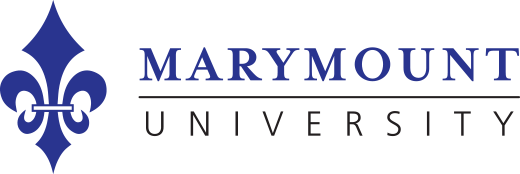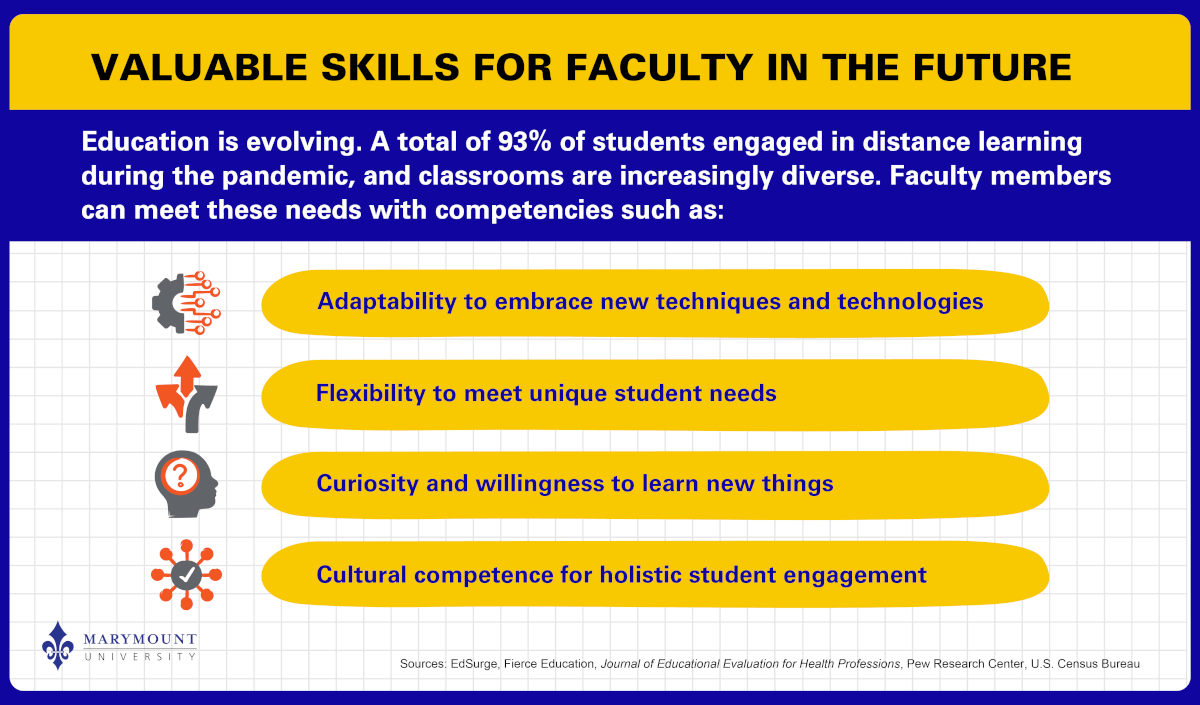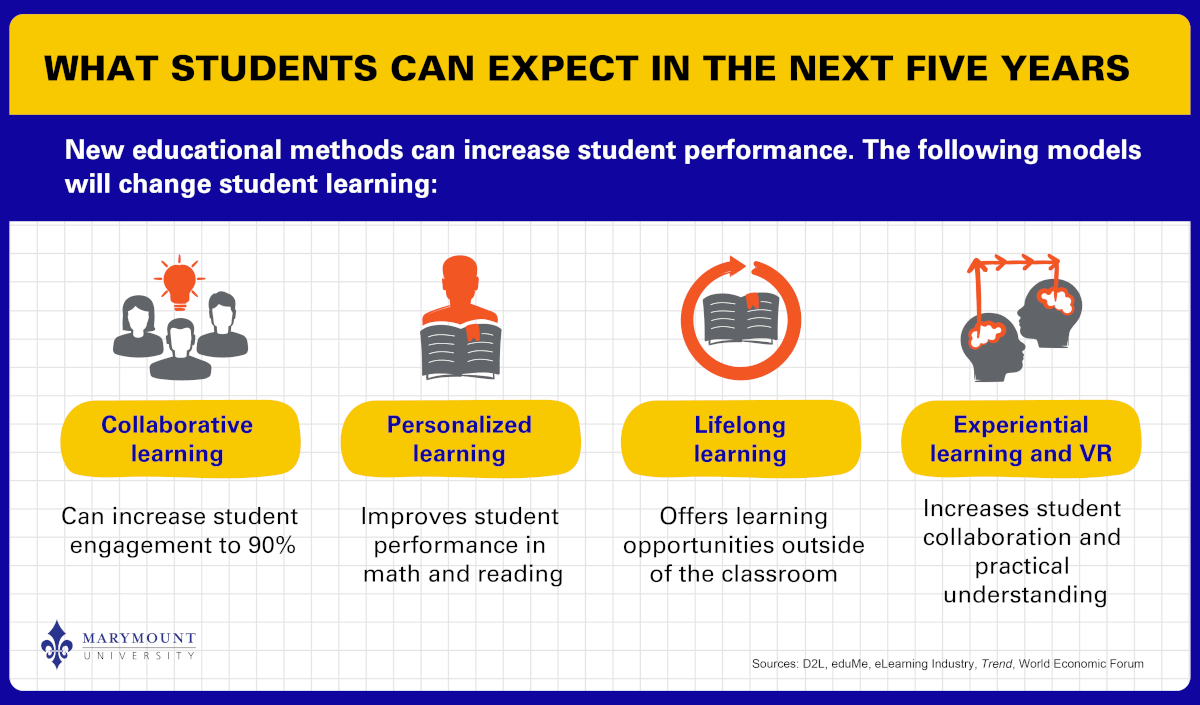The Future of Education

Updated October 16, 2024.
The COVID-19 pandemic disrupted every aspect of daily life, especially how people work and learn. The U.S. Census Bureau estimated that nearly 93% of households with school-age children participated in some form of remote learning during the pandemic, and the National Center for Education Statistics reported that 74% of college students took at least one class online. From educators to students to administrators, everyone involved in education adjusted to online learning environments and new learning experiences that quickly replaced traditional classroom models.
Nearly five years after the start of the COVID-19 crisis, school district leaders and faculty are reckoning with the lessons learned during the pandemic. Difficult times can lead to innovation and education stakeholders are not returning to the pre-pandemic status quo. Education leaders and teachers are increasingly adopting online and hybrid models to reach underserved student populations.
This article will examine the educational options available to schools on a collegiate and noncollegiate level in this increasingly digital world and the future of education, schools and teaching.
What Is the Future of Higher Education?
Various trends — from remote learning to formative assessment — are poised to shape the future of higher education. Each trend may also impact the future of teaching, student learning and education administration.
Trend #1: Artificial Intelligence
Artificial intelligence (AI) may be a recent buzz phrase but its impacts have already been felt in classrooms. A 2023 survey of K-12 teachers found that 51% of respondents already used ChatGPT for lesson planning, background research and lecture ideas.
However, AI use in college classrooms has lagged behind their K-12 counterparts. A 2023 faculty survey found only 18% of respondents were familiar with AI’s applications in higher education.
AI presents an opportunity for effective learning and efficient teaching practices. AI-powered tools like ChatGPT won’t replace educators or harm student progress toward their goals if they are effectively implemented. The U.S. Office of Education Technology emphasizes keeping “humans in the loop” - or people-guided AI applications - in its recommendations for AI adoption.
There are several frequently mentioned concerns about AI in the classroom including discrimination in automated scoring and student privacy. These concerns remain to be addressed by educators, policymakers and other stakeholders as AI becomes more commonplace in our lives.
Trend #2: Active Learning
A hallmark learning experience of higher education is taking notes during lectures. This kind of passive learning is limited and doesn’t fully engage students in the learning process.
By contrast, active learning includes meaningful, engaging learning activities that promote critical thinking and analytical skills. Examples of active learning are debating current events, interviewing experts in their fields and completing group projects with peers. University departments pursuing active learning goals need relevant extracurricular events, engaging classroom layouts and specialized training for faculty members.
Active learning is linked to positive student outcomes, such as a better understanding of the course material and higher course completion rates. Students also prefer interactive or active learning activities compared to traditional lectures. Respondents to a 2023 Student Voice Pulse survey found the following activities were most effective for retaining information:
- Case studies (49%)
- Game-based activities (38%)
- Small-group discussions (38%)
- Quick polls and surveys (32%)
- Partnered summarizing of lecture topics (27%)
Trend #3: Teaching More Relevant Skills
The skills that make students successful in the classroom don’t necessarily translate to the working world or make them successful in future jobs. There’s a trend toward teaching practical skills and concepts to better prepare students for employment in an evolving workforce.
Curricula are changing to include teaching job readiness skills. This change benefits students by preparing them for future employment after completing their degrees, making colleges and universities with higher employment placement rates after graduation look more attractive to prospective students.
For example, teaching students cultural competence is more important than ever in today's increasingly diverse society. Cultural competence allows students and professionals to effectively interact with people from different backgrounds and deliver quality, culturally sensitive services.
A LinkedIn review of job listings in 2023 found that interpersonal skills were in high demand across industries. The most important skills sought by employers were communication, customer service and leadership. A focus on practical skills in school can help students find jobs when they enter the workforce.
Trend #4: Formative Assessment
An alternative to summative assessment such as final exams, formative assessment involves real-time learning assessments that provide ongoing feedback to both faculty members and students. By regularly monitoring student learning — often through observation or pop quizzes — instructors can improve their teaching.
Formative assessment also has the power to enhance student learning. In the process, students identify their strengths and weaknesses, gaining a better understanding of how well they understand the course material.
In the coming years, formative assessment will continue to measure student achievement and shape learning experiences. With remote learning and the use of technology on the rise, one particular type of formative assessment could become increasingly popular: interview assessments. This can include casual chats with students or a peer feedback process.
Trend #5: Hybrid and Flexible Learning Environments
COVID-19 dramatically changed educational learning experiences, including how faculty members teach. To prepare for crises and world events that might affect the future of education, institutions must have a digital infrastructure in place to allow students to continue their education from wherever they are. Institutions must also pursue flexible education models, such as hybrid or fully remote learning.
Hybrid learning comprises both in-classroom and online discussions of course materials, and it is gaining popularity because it offers students the flexibility to personalize the education process to their unique needs. Students receive consistent support and guidance from professors and academic advisors both in person and through online tools.
Global learning companies are innovating to further facilitate and expand remote learning, introducing virtual lab applications and immersive story learning. Despite its popularity, remote learning has its drawbacks, such as distractions, technical difficulties, reduced social interaction between students and their peers, as well as between students and faculty members.
Beyond disruptive world events, there are many personal and economic reasons students will continue to choose the flexibility and convenience associated with remote learning. Before committing to remote learning, students should consider their comfort level with technology and self-discipline, among other factors.
Trend #6: Disruption of the Traditional College Experience
Attending in-person classes held in lecture halls with stadium seating among like-minded peers, living in a dorm and being immersed in the culture of the college - these experiences were disrupted by the COVID-19 pandemic. Future world events may once again prevent students from having a traditional college experience at a brick-and-mortar institution.
Colleges and universities need to find new ways to differentiate themselves beyond education and learning. Compelling differentiators might include the following:
- A focus on a particular student segment or field of study
- Financial aid assistance
- Career services and placement assistance
- Postgraduation employment rates
What Might the Future of K-12 Schools Look Like?
In the future of education, various factors — everything from extended school year services to learn-as-you-go scenarios — could potentially disrupt the traditional teacher-student dynamic at different education levels. Here are a few key trends expected to shape the future of schools.
Trend #1: Virtual Reality in the Classroom
We’ve already seen how traditional, in-person learning has evolved out of necessity over the past five years. Virtual reality (VR) technology can break these boundaries further by taking students to places far from home, even out of this world. The global market for education-related VR technology is expected to nearly quadruple in value from 2023 to 2032 because of its potential impacts.
VR can take students into the past, send them into space or fly them to locations across the globe. This technology offers opportunities for students with disabilities to experience the world based on their individual needs. Teachers can also help students become more comfortable with social interactions and public speaking during VR lessons.
The high costs of current VR technology may limit its short-term adoption. Concerns about screen time, distractions and disconnection from real-world experiences may also dampen parental enthusiasm for its use. Conversations about these limitations will shape how VR impacts schooling in the future.
Trend #2: Extended School Year Services
The term “extended school year” refers to education services offered to students in need of special accommodations for disabilities. These services are offered beyond the regular school year. At the K-12 level, these services are reserved for students with an individualized education program (IEP), and students and their families can request them through the disability services office of their institution. The National Center for Education Statistics (NCES) found 7.5 million students with IEPs in the United States in 2023, an all-time high.
Many K-12 students who have IEPs can participate in extended school year services. These services are typically offered during summer or winter vacation or winter break, when regular school isn’t in session. They’re useful for preventing learning loss and increasing academic achievement, especially for low-income students who might not otherwise have access to enriching learning experiences outside of school.
Trend #3: Outsourced Education
School districts, colleges and universities can cut costs by outsourcing education services to external organizations. Outsourced services can include everything from school therapy services (e.g., speech therapy and counseling) to technology. A 2019 study by the National Postsecondary Education Cooperative (NPEC) found that 91% of colleges and universities outsourced at least one service and 65% outsourced up to five services.
By outsourcing education services, educational institutions can save money on physical infrastructure, administrative overhead and employee benefits, while maintaining the services that students need. However, one ongoing concern about outsourced education is continuity with providers, which can hamper students’ ability to build relationships with the same educators and therapists at each appointment.
Trend #4: Transforming Schools Into Learning Hubs
Learning hubs offer a unique approach that could revolutionize schools. Small hubs, or micro-schools, offer student-centered, personalized learning within larger schools. Themed hubs are another trend that can differentiate these learning communities based on topics such as career pathways, social development or health and wellness.
Learning hubs might help foster deeper connections between instructors and students as instructors engage with students around their curiosity and interests. Hubs might also extend beyond the traditional school day to offer students tutoring, college prep courses, enrichment activities and more.
Trend #5: Learn-as-You-Go Scenarios
Self-paced learning and real-world applications are two important learn-as-you-go scenarios. Self-paced learning experiences customize education, offering students the time and space to complete and absorb learning tasks, instead of demanding that they keep up with their peers. To further advance education, real-world applications — such as project-based learning — are essential to help students understand how they can apply what they learn in the classroom to everyday situations.
In particular, self-paced learning can positively impact a student’s social-emotional needs. If a student needs more attention, a faculty member can provide it without slowing down the rest of the classroom. Also, teachers can make learning more meaningful and increase student engagement by assigning projects that apply concepts learned in the classroom to real-world scenarios.
Benefits and Challenges of Online Learning
A recent RAND study reported that 1 in 5 U.S. school district leaders plan to offer virtual learning in the future. The demand for online education in the current educational environment is on the rise. To understand the extent to which it might replace traditional on-campus learning, understanding its benefits and challenges is essential.
The key benefits of online learning include the following:
- Student location is less relevant, allowing students to log in to a discussion board or watch a lecture from anywhere
- Greater school-life balance, as eliminating the commute time frees up students to pursue hobbies and maintain social and family time outside of school
- Career advancement, as maintaining a job means students can pursue their education while learning new skills on the job or providing for their family
- Skill building, allowing students to improve everything from time management and communication skills to self-discipline and technical skills
Some common challenges associated with online learning are as follows:
- Staying focused in the midst of distractions, as students potentially have to work harder to find a quiet, productive workspace
- Technical issues, such as preventing students from accessing online learning sessions can put them behind in their work and cause frustration
- Reduced social interaction prevents students from interacting regularly with their peers can be challenging and lead to feelings of isolation
- Finding motivation may be more difficult, as students may be tempted to procrastinate without regular, in-person peer interaction or attention from educators
Beyond students overcoming the challenges associated with online learning, these educational environments can only grow if teachers have the necessary technical and adaptability skills as a foundation. The future of online teaching requires teachers to have a certain degree of technical proficiency to record and post lectures, lead online classrooms, check assignments submitted virtually and communicate with students on discussion boards.
Educational faculty can facilitate strong online learning experiences in numerous ways. One option is setting up virtual classroom activities requiring students to collaborate in small groups, encouraging the essential peer interaction that students might not get elsewhere. Another option is encouraging local students to meet face-to-face outside the online classroom.
Examples of Future Learning Styles
Various learning experience models are emerging and can be expected to impact the future of schools and teaching.
Collaborative Learning
Collaborative learning occurs when students complete educational activities in pairs or groups. Peer teaching and small group discussions are two examples. Educators can use this type of model to help students build their self-esteem and prepare them to be a part of a team.
Personalized Learning
One of the more controversial models is personalized learning, which involves customizing the learning experience for students based on their unique backgrounds and abilities. Intending to improve student outcomes, personalized learning usually involves adaptive software capable of adjusting to a student’s skill level. To implement personalized learning, teachers must be able to use the corresponding technology.
Critics of personalized learning are concerned about this model's excessive computer screen time and point to privacy concerns around student data.
Lifelong Learning
Lifelong learning will appeal to students interested in personal development and gaining new skills and knowledge outside of a formal educational institute. This learning experience model can be helpful to students who want a competitive edge in the job market, as they have the opportunity to develop new professional skills.
With the rise of technology and a rapidly changing workplace, lifelong learning is more relevant than ever, and self-initiated learning will likely be in greater demand in the future. Educators can encourage students to pursue lifelong learning and inspire them by sharing any initiatives they’ve completed to pursue their passions and interests.
Experiential Learning
A prime example of experiential learning is a case study group project in which students collaborate to reflect on real-world solutions and come up with solutions. Educators at all levels can use this type of learning experience to teach problem-solving skills and critical thinking. Colleges and universities can take experiential learning one step further by including internships and fellowships.
What Is the Future of Teaching? Trends and Areas of Focus
COVID-19 changed the way teachers connect with students and create learning experiences. Emerging and projected trends, such as online learning, micro-schools and outsourced education, may alter the teaching profession.
These trends are significant because they impact a teacher’s ability to meet future education-based benchmarks and goals. To overcome these challenges, teachers will need to focus on the following:
- Teaching and technical skills. Teachers engaged in virtual classrooms can take advantage of education technology, including tools such as tablets and interactive whiteboards. Training will be needed to ensure each teacher’s level of technological competence and familiarity with online learning best practices.
- Teaching diversity and global citizenship in the classroom. In the U.S., the racial and ethnic backgrounds of teachers are less diverse than those of the students. Greater teacher diversity is needed to represent minority students better, engage their parents and improve their academic achievement. Also, to thrive in a diverse global society, teachers must help students become global citizens by exploring the human experience across different cultures, races and ethnicities.
- Providing broader teaching environments. The future of teaching may be revolutionized in the coming years by online learning tools, asynchronous learning opportunities and virtual reality (VR). In particular, VR enables learning through play and experiences, allowing teachers to create a more collaborative and interactive learning environment.
How Will Faculty Members Handle the Future?
Educational institutions rely on trained professionals to operate and serve students. This includes front-line administrative staff, faculty and professors, health care professionals and mental health counselors, and operations staff. Teaching faculty have the most direct contact with the student population and will require specific skills and characteristics to succeed in the classroom of tomorrow.
The skills and characteristics that faculty members need to keep up with the future of education include the following:
- Technical knowledge. Now that education technology is a permanent fixture in today’s classrooms, faculty need to be tech-savvy. This includes everything from managing online learning environments to performing basic video editing.
- Adaptability. Education needs to plan for future pandemics and world events that may disrupt it. Teachers must be ready to navigate disruptions that may change the nature of teaching. Adaptability is associated with overall well-being, which can improve a teacher’s mental health. Additionally, a willingness to learn goes hand-in-hand with adaptability.
- Flexibility. Teachers are commonly asked to juggle several responsibilities at once, and the most successful educators do this effectively. Flexibility in teaching refers to the ability to adjust a planned lesson or schedule in real-time to accommodate the students’ needs and curiosity, promoting increased student participation and overall engagement.
- Curiosity. Curiosity is critical for faculty to learn and grow. Curiosity can strengthen a teacher’s mind, making for more effective educators. Curious teachers can improve the classroom by creating lesson plans and engaging learning experiences.
- Cultural competence. Faculty members need to be able to interact effectively with students, parents and colleagues from diverse cultures. Teachers must have an understanding of bias, stereotypes and cultural differences. Furthermore, a teacher who comes from a different community than the one served by the school should educate themselves about the school’s local community.
Online Learning and Teaching Resources
Educational faculty can further develop robust online teaching strategies by reviewing the following resources:
- The California Department of Education, the government agency that oversees public education for the most K-12 students in the nation, has compiled a list of free remote learning resources from external publishers.
- A nonprofit composed of communication academics and headquartered in Washington, DC, the National Communication Association offers a helpful array of infographics, tips and articles focused on online learning.
Committed to advancing justice and excellence in public education, the National Education Association offers free online learning resources and lesson plans.
Cultural Competence and Adaptability Resources
The following resources can help educational faculty strengthen their knowledge about concepts like cultural competence and adaptability:
- TIP 59: Improving Cultural Competence, a free downloadable publication available from the National Center for Biotechnology Information database, is based on a well-known multidimensional model for developing cultural competence.
- Headquartered in Minnesota, the PACER Center is a champion for children with disabilities in Minnesota and across the nation. It has videos and PDF downloads on how to work effectively with families from diverse cultures.
The National Education Association offers a cultural competence training program to help develop culturally-conscious and sensitive educators. It has three-hour and four-hour session options.
Approach The Future of Education with Marymount University
Marymount University’s Online Doctor of Education (Ed.D.) in Leadership & Organizational Innovation is designed for educational change agents. This entirely online degree can be completed in less than three years of study. Graduates of the Ed.D. program are prepared for careers as principals, superintendents and leadership roles outside of education.
The program’s 48-credit curriculum focuses on practical applications of advanced leadership lessons. Experienced education leaders teach courses like Ethical Leadership & Social Justice and Transformative Leadership. Every Ed.D. candidate completes a Dissertation in Practice focused on real-world solutions for leadership challenges.
The Ed.D. program is among a select group of universities participating in the Carnegie Project on the Education Doctorate (CPED). Marymount University holds accreditation from the Southern Association of Colleges and Schools Commission on Colleges (SACSCOC) for the program.
Become a leading force in the future of education by learning from a leading university. Connect with an enrollment advisor to learn more about how the Ed.D. can help you inspire change in your community.


